Impacts of COVID-19-Induced Human Mobility Changes on Global Wildfire Activity
Abstract
1. Introduction
2. Materials and Methods
2.1. Data Resource
2.2. Research Methods
3. Results
3.1. Changes in the Number of Global Hotspots Before and After the COVID-19 Incidents
3.2. Changes in the Spatial Distribution Patterns of Global Hotspot Counts Before and After the COVID-19 Incidents
3.3. Comparison of Hotspot Changes Across Countries/Administrative Regions Globally Before and After the COVID-19 Incidents
3.4. Comparison of Monthly Hotspot Changes Across Countries/Administrative Regions Globally Before and After the COVID-19 Incidents
4. Discussion
5. Conclusions
Supplementary Materials
Author Contributions
Funding
Institutional Review Board Statement
Informed Consent Statement
Data Availability Statement
Conflicts of Interest
References
- Lou, H.; Cai, H.; Fu, R.; Guo, C.; Fan, B.; Hu, H.; Zhang, J.; Sun, L. Effects of wildfire disturbance on forest soil microbes and colonization of ericoid mycorrhizal fungi in northern China. Environ. Res. 2023, 231, 13. [Google Scholar] [CrossRef]
- Ahmed, I.; Ledger, K. Lessons from the 2019/2020 ‘Black Summer Bushfires’ in Australia. Int. J. Disaster Risk Reduct. 2023, 96, 103947. [Google Scholar] [CrossRef]
- Wu, J.T.; Leung, K.; Leung, G.M. Nowcasting and forecasting the potential domestic and international spread of the 2019-nCoV outbreak originating in Wuhan, China: A modelling study. Lancet 2020, 395, 689–697. [Google Scholar] [CrossRef] [PubMed]
- Islam, S.M.D.-U.; Bodrud-Doza, M.; Khan, R.M.; Haque, M.A.; Mamun, M.A. Exploring COVID-19 stress and its factors in Bangladesh: A perception-based study. Heliyon 2020, 6, e04399. [Google Scholar] [CrossRef] [PubMed]
- Wang, Z.; Mu, J.; Yang, M.; Yu, X. Reexamining the mechanisms of East Asian summer monsoon changes in response to Non–East Asian anthropogenic aerosol forcing. J. Clim. 2020, 33, 2929–2944. [Google Scholar] [CrossRef]
- Razzaq, A.; Sharif, A.; Aziz, N.; Irfan, M.; Jermsittiparsert, K. Asymmetric link between environmental pollution and COVID-19 in the top ten affected states of US: A novel estimations from quantile-onquantile approach. Environ. Res. 2020, 191, 110–189. [Google Scholar] [CrossRef]
- Zhou, D.; Dai, S.M.; Tong, Q. COVID-19: A recommendation to examine the effect of hydroxychloroquine in preventing infection and progression. J. Antimicrob. Chemother. 2020, 75, 1667–1670. [Google Scholar] [CrossRef]
- Li, L.; Li, Q.; Huang, L.; Wang, Q.; Zhu, A.; Xu, J.; Liu, Z.; Li, H.; Shi, L.; Li, R.; et al. Air quality changes during the COVID-19 lockdown over the Yangtze River Delta Region: An insight into the impact of human activity pattern changes on air pollution variation. Sci. Total Environ. 2020, 732, 139282. [Google Scholar] [CrossRef]
- Du, Z.; Xu, X.K.; Wang, L.; Fox, S.J.; Cowling, B.J.; Galvani, A.P.; Meyers, L.A. Effects of proactive social distancing on COVID-19 outbreaks in 58 cities, China. Emerg. Infect. Dis. 2020, 26, 2267–2269. [Google Scholar] [CrossRef]
- Somani, M.; Srivastava, A.N.; Gummadivalli, S.K.; Sharma, A. Indirect implications of COVID-19 towards sustainable environment: An investigation in Indian context. Bioresour. Technol. Rep. 2020, 11, 100491. [Google Scholar] [CrossRef]
- Tobías, A. Evaluation of the lockdowns for the SARS-CoV-2 epidemic in Italy and Spain after one month follow up. Sci. Total Environ. 2020, 725, 138539. [Google Scholar] [CrossRef] [PubMed]
- Klemeš, J.J.; Fan, Y.V.; Tan, R.R.; Jiang, P. Minimising the present and future plastic waste, energy and environmental footprints related to COVID-19. Renew. Sustain. Energy Rev. 2020, 127, 109883. [Google Scholar] [CrossRef]
- Forster, P.M.; Forster, H.I.; Evans, M.J.; Gidden, M.J.; Jones, C.D.; Keller, C.A.; Lamboll, R.D.; Quéré CLe Rogelj, J.; Rosen, D.; Schleussner, C.; et al. Current and future global climate impacts resulting from COVID-19. Nat. Clim. Chang. 2020, 10, 913–919. [Google Scholar] [CrossRef]
- Le Quéré, C.; Jackson, R.B.; Jones, M.W.; Smith, A.J.P.; Abernethy, S.; Andrew, R.M.; De-Gol, A.J.; Willis, D.R.; Shan, Y.; Canadell, J.G.; et al. Temporary reduction in daily global CO2 emissions during the COVID-19 forced confinement. Nat. Clim. Chang. 2020, 10, 647–653. [Google Scholar] [CrossRef]
- Jones, C.D.; Hickman, J.E.; Rumbold, S.T.; Walton, J.; Ziehn, T. The climate response to emissions reductions due to COVID-19: Initial results from CovidMIP. Geophys. Res. Lett. 2021, 48, e2020GL091883. [Google Scholar] [CrossRef]
- Usman, M.; Husnain, M.; Riaz, A.; Riaz, A.; Ali, Y. Climate change during the COVID-19 outbreak: Scoping future perspectives. Environ. Sci. Pollut. Res. 2021, 28, 49302–49313. [Google Scholar] [CrossRef]
- Askitas, N.; Tatsiramos, K.; Verheyden, B. Lockdown strategies, mobility patterns and COVID-19. Covid Econ. 2020, 23, 263–302. [Google Scholar]
- Baldwin, R.; Tomiura, E. Thinking ahead about the trade impact of COVID-19. Econ. Time COVID-19 2020, 59, 59–71. [Google Scholar]
- Bates, A.E.; Primack, R.B.; Moraga, P.; Duarte, C.M. COVID-19 pandemic and associated lockdown as a “Global Human Confinement Experiment” to investigate biodiversity conservation. Biol. Conserv. 2020, 248, 108665. [Google Scholar] [CrossRef]
- Sánchez-Clavijo, L.M.; Martínez-Callejas, S.J.; Acevedo-Charry, O.; Diaz-Pulido, A.; Ochoa-Quintero, J.M. Differential reporting of biodiversity in two citizen science platforms during COVID-19 lockdown in colombia. Biol. Conserv. 2021, 256, 109077. [Google Scholar] [CrossRef]
- Sills, J.; Pearson, R.M.; Sievers, M.; McClure, E.C.; Turschwell, M.P.; Connolly, R.M. COVID-19 recovery can benefit biodiversity. Science 2020, 368, 838–839. [Google Scholar]
- Zambrano-Monserrate, M.A.; Ruano, M.A.; Sanchez-Alcalde, L. Indirect effects of COVID-19 on the environment. Sci. Total Environ. 2020, 728, 138813. [Google Scholar] [CrossRef]
- Corlett, R.T.; Primack, R.B.; Devictor, V.; Maas, B.; Goswami, V.R.; Bates, A.E.; Koh, L.; Regan, T.J.; Loyola, R.; Pakeman, R.J.; et al. Impacts of the coronavirus pandemic on biodiversity conservation. Biol. Conserv. 2020, 246, 108571. [Google Scholar] [CrossRef] [PubMed]
- Pinder, A.C.; Raghavan, R.; Britton, J.R.; Cooke, S.J. COVID⁃19 and biodiversity: The paradox of cleaner rivers and elevated extinction risk to iconic fish species. Aquat. Conserv. 2020, 30, 1061–1062. [Google Scholar] [CrossRef]
- Rahman, M.S.; Alam, M.A.; Salekin, S.; Belal, M.A.; Rahman, M.S. The COVID-19 pandemic: A threat to forest and wildlife conservation in Bangladesh? Trees For. People 2021, 5, 100119. [Google Scholar] [CrossRef]
- Sannigrahi, S.; Pilla, F.; Maiti, A.; Bar, S.; Bhatt, S.; kaparwan, A.; Zhang, Q.; Keesstra, S.; Cerda, A. Examining the status of forest fire emission in 2020 and its connection to COVID-19 incidents in West Coast regions of the United States. Environ. Res. 2022, 210, 112818. [Google Scholar] [CrossRef] [PubMed]
- Lugo-Robles, R.; Garges, E.; Olsen, C.; Brett-Major, D.M. Identifying nontraditional epidemic disease risk factors associated with major health events from world health organization and world bank open data. Am. J. Trop. Med. Hyg. 2021, 105, 896–902. [Google Scholar] [CrossRef]
- Fang, T.; Hwang, B.C.H.; Kapur, S.; Hopstock, K.S.; Wei, J.; Nguyen, V.; Nizkorodov, S.A.; Shiraiwa, M. Wildfire particulate matter as a source of environmentally persistent free radicals and reactive oxygen species. Environ. Sci. Atmos. 2023, 3, 14. [Google Scholar] [CrossRef]
- Zhou, M.; Hu, T.; Zhang, W.; Wang, Q.; Kong, L.; Zhou, M.; Rao, P.; Peng, W.; Chen, X.; Song, X. COVID-19 pandemic: Impacts on air quality and economy before, during and after lockdown in China in 2020. Environ. Technol. 2023, 44, 3063–3073. [Google Scholar] [CrossRef]
- Lawler, O.K.; Allan, H.L.; Baxter, P.W.J.; Castagnino, R.; Tor, M.C.; Dann, L.E. The COVID-19 pandemic is intricately linked to biodiversity loss and ecosystem health. Lancet. Planet. Health 2021, 5, e840–e850. [Google Scholar] [CrossRef]
- Poulter, B.; Freeborn, P.H.; Jolly, W.M.; Varner, J.M. Covid-19 lockdowns drive decline in active fires in southeastern United States. Proc. Natl. Acad. Sci. U.S.A. 2021, 118, e2105666118. [Google Scholar] [CrossRef] [PubMed]
- Eklund, J.; Jones, J.P.G.; Räsänen, M.; Geldmann, J.; Jokinen, A.; Pellegrini, A.; Rakotobe, D.; Sarobidy, R.O.; Toivonen, T.; Balmford, A. Elevated fires during COVID-19 lockdown and the vulnerability of protected areas. Nat. Sustain. 2022, 5, 603–609. [Google Scholar] [CrossRef]
- Zhang, Z.; Song, G.; Zhang, L.; Zhai, Z.; He, W.; Yin, H.; Yu, L. Impact of lockdown policies on urban traffic conditions and carbon dioxide emissions based on an emission model on the link level in hour granularity. J. Clean. Prod. 2024, 437, 140426. [Google Scholar] [CrossRef]
- Kountouris, Y. Human activity, daylight saving time and wildfire occurrence. Sci. Total Environ. 2020, 727, 138044. [Google Scholar] [CrossRef] [PubMed]
- Balch, J.K.; Bradley, B.A.; Abatzoglou, J.T.; Nagy, R.C.; Fusco, E.J.; Mahood, A.L. Human-started wildfires expand the fire niche across the United States. Proc. Natl. Acad. Sci. USA 2017, 114, 2946–2951. [Google Scholar] [CrossRef]
- Hamilton, R.; Penny, D.; Hall, T.L. Forest, fire & monsoon: Investigating the long-term threshold dynamics of south-east Asia’s seasonally dry tropical forests. Quat. Sci. Rev. 2020, 238, 106334. [Google Scholar]
- Gonzalez-Mathiesen, C.; Ruane, S.; March, A. Integrating wildfire risk management and spatial planning—A historical review of two Australian planning systems. Int. J. Disaster Risk Reduct. 2020, 53, 101984. [Google Scholar] [CrossRef]
- Carrasco-Escaff, T.; Garreaud, R.; Bozkurt, D.; Jacques-Coper, M.; Pauchard, A. The key role of extreme weather and climate change in the occurrence of exceptional fire seasons in south-central Chile. Weather Clim. Extrem. 2024, 45, 100716. [Google Scholar] [CrossRef]
- Abatzoglou, J.T.; Williams, A.P. Impact of anthropogenic climate change on wildfire across western US forests. Proc. Natl. Acad. Sci. USA 2016, 113, 11770–11775. [Google Scholar] [CrossRef]
- Kirchmeier-Young, M.C.; Zwiers, F.W.; Gillett, N.P.; Cannon, A.J. Attributing extreme fire risk in Western Canada to human emissions. Clim. Chang. 2017, 144, 365–379. [Google Scholar] [CrossRef]
- Van Oldenborgh, G.J.; Krikken, F.; Lewis, S.; Lewis, S.; Leach, N.J.; Lehner, F.; Saunders, K.R.; van Weele, M.; Haustein, K.; Li, S.; et al. Attribution of the Australian bushfire risk to anthropogenic climate change. Nat. Hazards Earth Syst. Sci. 2021, 21, 941–960. [Google Scholar] [CrossRef]
- Jain, P.; Sharma, A.R.; Acuna, D.C.; Abatzoglou, J.T.; Flannigan, M. Record-breaking fire weather in north America in 2021 was initiated by the pacific northwest heat dome. Commun. Earth Environ. 2024, 5, 202. [Google Scholar] [CrossRef]
- Kharuk, V.I.; Dvinskaya, M.L.; Im, S.T.; Golyukov, A.S.; Smith, K.T. Wildfires in the Siberian Arctic. Fire 2022, 5, 106. [Google Scholar] [CrossRef]
- Sharma, S.; Zhang, M.; Anshika, S.; Gao, J.; Zhang, H.; Kota, S.H. Effect of restricted emissions during COVID-19 on air quality in India. Sci. Total Environ. 2020, 728, 138878. [Google Scholar] [CrossRef] [PubMed]
- Ren, L.; Yang, Y.; Wang, H.; Wang, P.; Yue, X.; Liao, H. Widespread wildfires over the western United States in 2020 linked to emissions reductions during COVID-19. Geophys. Res. Lett. 2022, 49, e2022GL099308. [Google Scholar] [CrossRef]
- Yang, Y.; Ren, L.; Li, H.; Wang, H.; Wang, P.; Chen, L.; Yue, X.; Liao, H. Fast climate responses to aerosol emission reductions during the COVID-19 pandemic. Geophys. Res. Lett. 2020, 47, e2020GL089788. [Google Scholar] [CrossRef]
- Henderson, K.; Chakrabortty, R.K. A machine learning predictive model for bushfire ignition and severity: The Study of Australian black summer bushfires. Decision Analytics Journal. 2025, 14, 100529. [Google Scholar] [CrossRef]
- Patel, L.; Conlon, K.; Sorensen, C.; Kathryn, C.; McEachin, S.; Nadeau, K.; Kakkad, K.; Kizer, K.W. Climate Change and Extreme Heat Events: How Health Systems Should Prepare. NEJM Catal. Innov. Care Deliv. 2022, 3, CAT-21. [Google Scholar] [CrossRef]
- Lupascu, M.; Taillardat, P.; Sasmito, S.D.; Agus, F.; Mudiyarso, D.; Ramchunder, S.J.; Tata, H.L.; Taylor, D. Climate-smart peatland management and the potential for synergies between food security and climate change objectives in Indonesia. Glob. Environ. Chang. 2023, 82, 102731. [Google Scholar] [CrossRef]
- Rantanen, M.; Karpechko, A.Y.; Lipponen, A.; Nordling, K.; Hyvärinen, O.; Ruosteenoja, K.; Vihma, T.; Laaksonen, A. The Arctic has warmed nearly four times faster than the globe since 1979. Commun. Earth Environ. 2022, 3, 168. [Google Scholar] [CrossRef]
- Alexander, M.; Unruh, L.; Koval, A.; Belanger, W. United States response to the COVID-19 pandemic, January–November 2020. Health Econ. Policy Law 2022, 17, 62–75. [Google Scholar] [CrossRef] [PubMed]
- Xiong, Q.; Luo, X.; Liang, P.; Xiao, Y.; Xiao, Q.; Sun, H.; Pan, K.; Wang, L.; Li, L.; Pang, X. Fire from policy, human interventions, or biophysical factors? Temporal-spatial patterns of forest fire in southwestern China. For. Ecol. Manag. 2022, 474, 118381. [Google Scholar] [CrossRef]
- Russell, E.N.; Loikith, P.C.; Ajibade, I.; Done, J.M.; Lower, C. The meteorology and impacts of the September 2020 Western United States extreme weather event. Weather Clim. Extrem. 2024, 43, 100647. [Google Scholar] [CrossRef]
- Vadrevu, K.; Eaturu, A.; Casadaban, E.; Lasko, K.; Schroeder, W.; Biswas, S.; Giglio, L.; Justice, C. Spatial variations in vegetation fires and emissions in South and Southeast Asia during COVID-19 and pre-pandemic. Sci. Rep. 2022, 12, 18233. [Google Scholar] [CrossRef]
- Allin, S.; Fitzpatrick, T.; Marchildon, G.P.; Quesnel-Vallée, A. The federal government and Canada’s COVID-19 responses: From ‘we’re ready, we’re prepared’ to ‘fires are burning’. Health Econ. Policy Law 2022, 17, 76–94. [Google Scholar] [CrossRef]
- Liang, S.; Ziegler, A.D.; Li, L.Z.X.; Jie Wu Wang, D.; Zeng, Z. Interplay of greening and ENSO on biosphere-atmosphere processes in Australia. Geosci. Lett. 2022, 9, 43. [Google Scholar] [CrossRef]
- Wells, E.M.; Beval, E.; Kay, S.; Small, M.J.; Wong-Parodi, G. Quantifying wildland fire resources deployed during the compound threat of COVID-19. Sci. Rep. 2024, 14, 20039. [Google Scholar] [CrossRef]
- Chen, A.; Yang, L.; Kang, H.; Gao, Y.; Xie, Z. Southern hemisphere fire history since the late glacial, reconstructed from an Antarctic sediment core. Quat. Sci. Rev. 2022, 276, 107300. [Google Scholar] [CrossRef]
- Liu, P.; Kaplan, J.O.; Mickley, L.J.; Li, Y.; Chellman, N.J.; Arienzo, M.M.; Kodros, J.K.; Pierce, J.R.; Sigl, M.; McConnell, J.R. Improved estimates of preindustrial biomass burning reduce the magnitude of aerosol climate forcing in the Southern Hemisphere. Sci. Adv. 2021, 7, eabc1379. [Google Scholar] [CrossRef]
- Ciavarella, A.; Cotterill, D.; Stott, P.; Kew, S.; Philip, S.; Oldenborgh, G.J.; Skålevåg, A.; Lorenz, P.; Robin, Y.; Otto, F.; et al. Prolonged Siberian heat of 2020 almost impossible without human influence. Clim. Chang. 2021, 166, 9. [Google Scholar] [CrossRef]
- Abatzoglou, J.T.; Rupp, D.E.; O’Neill, L.W.; Sadegh, M. Compound Extremes Drive the Western Oregon Wildfires of September 2020. Geophys. Res. Lett. 2021, 48, e2021GL092520. [Google Scholar] [CrossRef]
- Mazhar, U.; Jin, S.; Bilal, M.; Ali, M.A.; Khan, R. Reduction of surface radiative forcing observed from remote sensing data during global COVID-19 lockdown. Atmos. Res. 2021, 261, 105729. [Google Scholar] [CrossRef] [PubMed]
- Van Heerwaarden, C.C.; Mol, W.B.; Veerman, M.A.; Benedict, I.; Heusinkveld, B.G.; Knap, W.H.; Kazadzis, S.; Kouremeti, N.; Fiedler, S. Record high solar irradiance in Western Europe during first COVID-19 lockdown largely due to unusual weather. Commun. Earth Environ. 2021, 2, 37. [Google Scholar] [CrossRef]
- Fiedler, S.; Wyser, K.; Rogelj, J.; van Noije, T. Radiative effects of reduced aerosol emissions during the COVID-19 pandemic and the future recovery. Atmos. Res. 2021, 264, 105866. [Google Scholar] [CrossRef]
- Nobrega, T.F.; Correia, A.L. Particulate and Gas Emissions from Wildfires in the Southern Amazon, from 2020 to 2022, from GOES-16 Fire Radiative Power Retrievals. ACS EST Air 2025, 2, 736–745. [Google Scholar] [CrossRef]
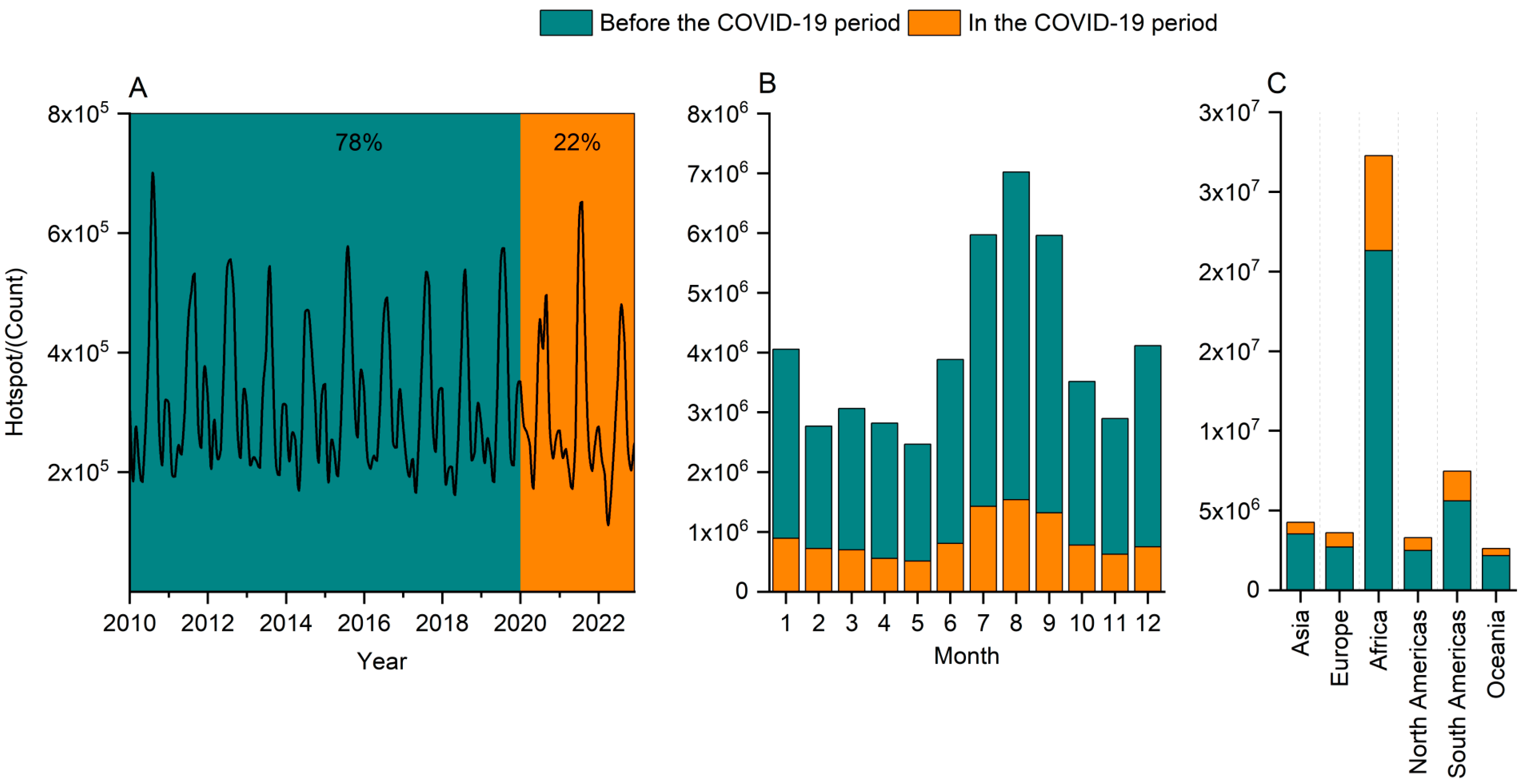
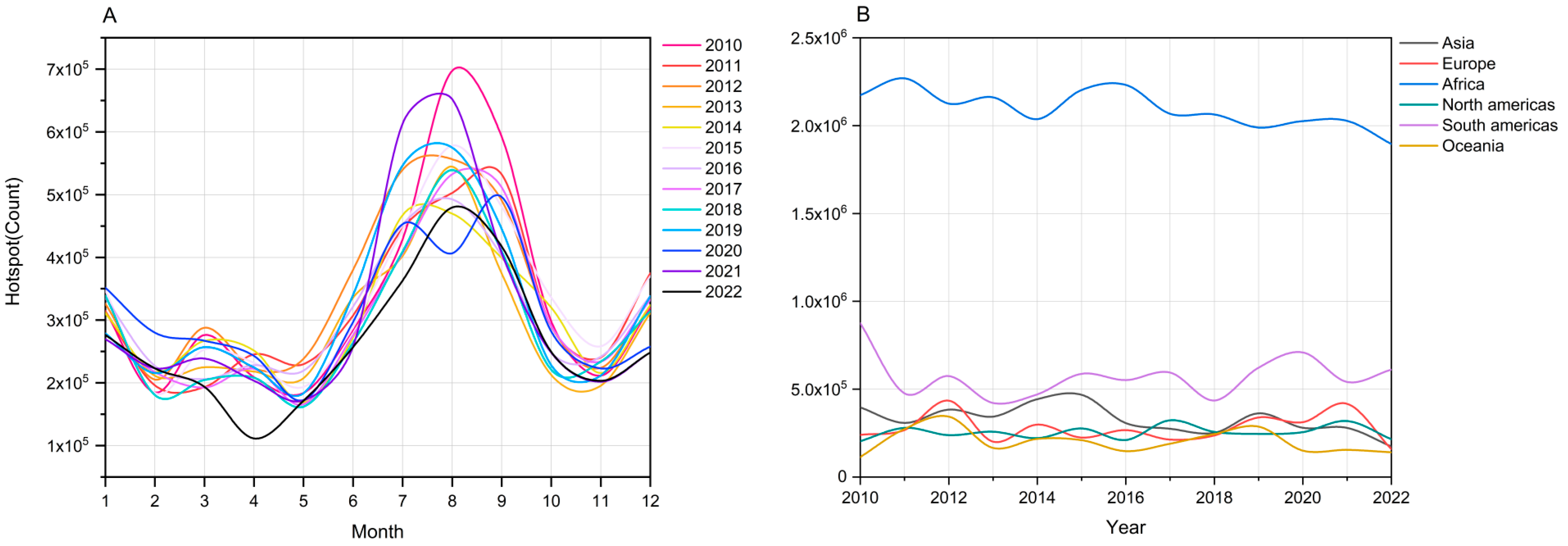

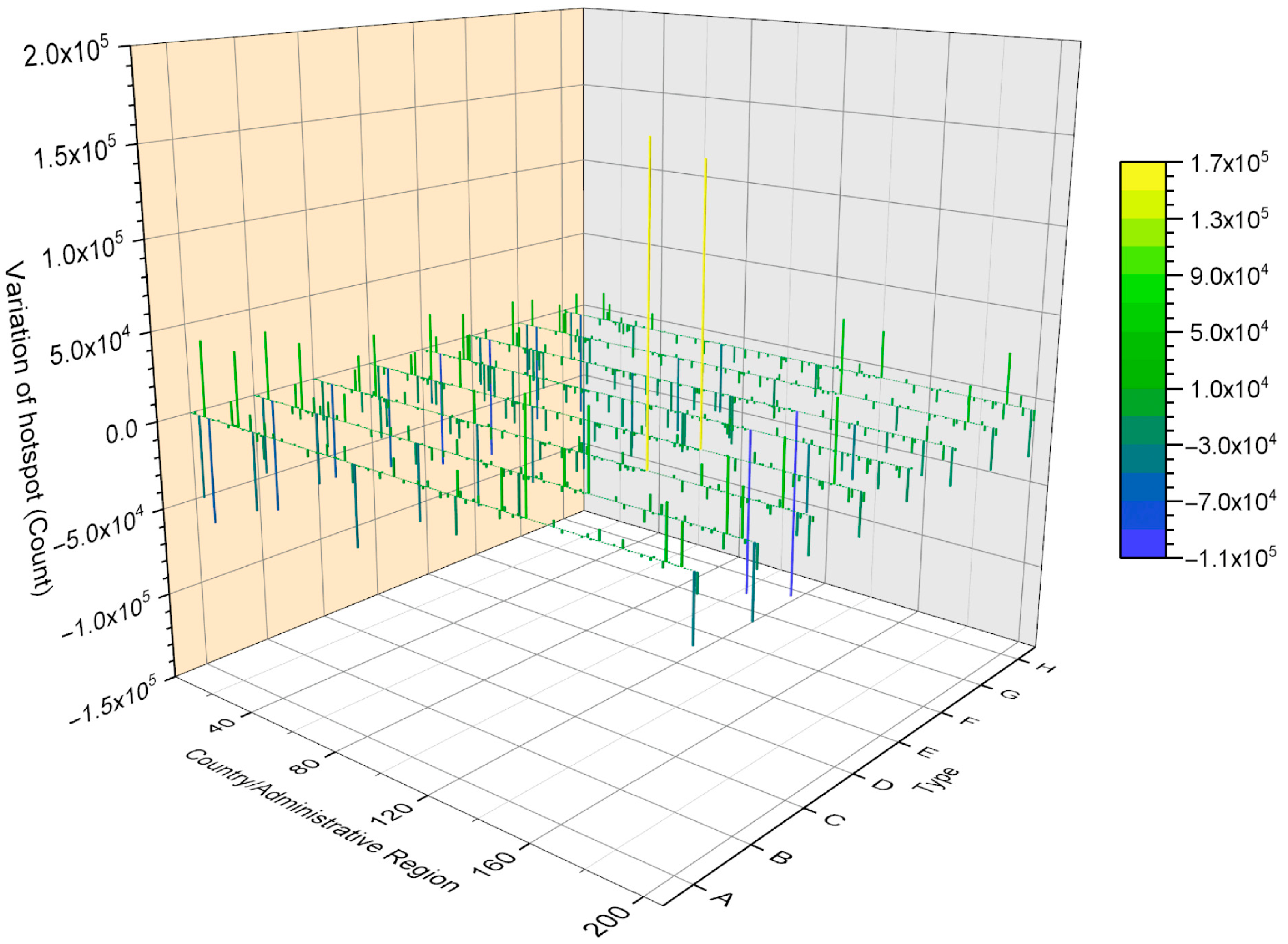

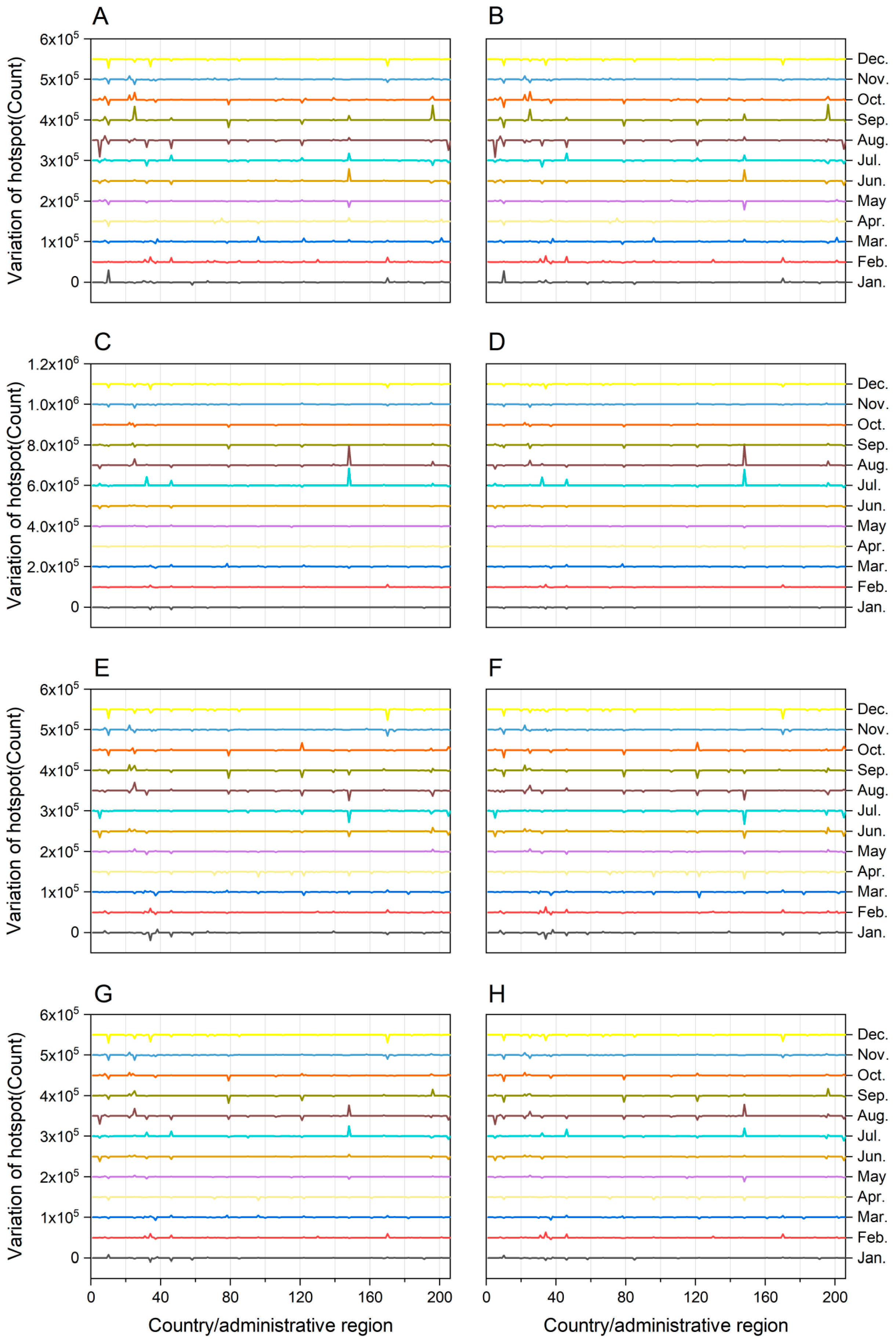
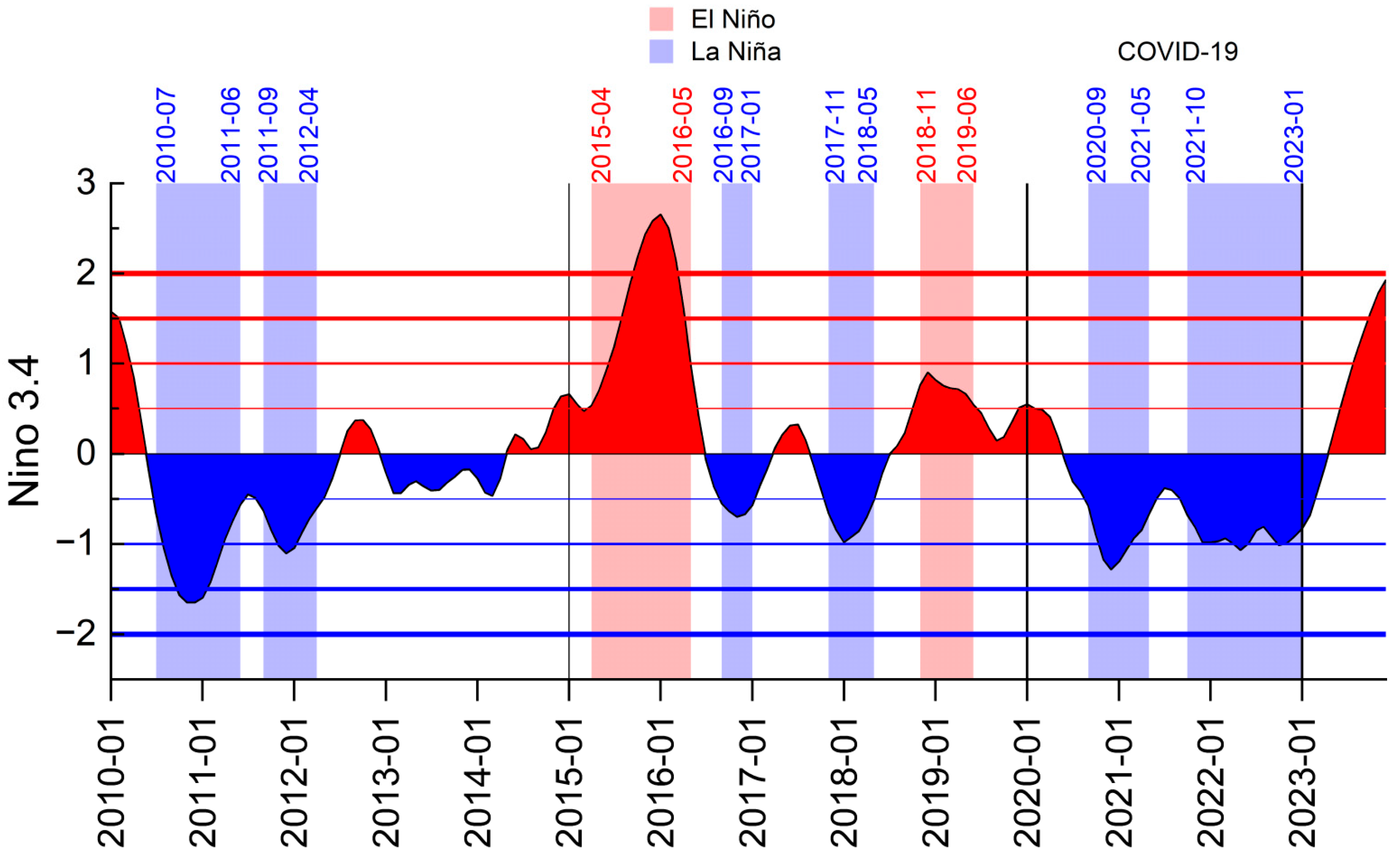
Disclaimer/Publisher’s Note: The statements, opinions and data contained in all publications are solely those of the individual author(s) and contributor(s) and not of MDPI and/or the editor(s). MDPI and/or the editor(s) disclaim responsibility for any injury to people or property resulting from any ideas, methods, instructions or products referred to in the content. |
© 2025 by the authors. Licensee MDPI, Basel, Switzerland. This article is an open access article distributed under the terms and conditions of the Creative Commons Attribution (CC BY) license (https://creativecommons.org/licenses/by/4.0/).
Share and Cite
Si, L.; Li, W.; Wang, M.; Shu, L.; Chen, F.; Zhao, F.; Cheng, P.; Li, W. Impacts of COVID-19-Induced Human Mobility Changes on Global Wildfire Activity. Fire 2025, 8, 276. https://doi.org/10.3390/fire8070276
Si L, Li W, Wang M, Shu L, Chen F, Zhao F, Cheng P, Li W. Impacts of COVID-19-Induced Human Mobility Changes on Global Wildfire Activity. Fire. 2025; 8(7):276. https://doi.org/10.3390/fire8070276
Chicago/Turabian StyleSi, Liqing, Wei Li, Mingyu Wang, Lifu Shu, Feng Chen, Fengjun Zhao, Pengle Cheng, and Weike Li. 2025. "Impacts of COVID-19-Induced Human Mobility Changes on Global Wildfire Activity" Fire 8, no. 7: 276. https://doi.org/10.3390/fire8070276
APA StyleSi, L., Li, W., Wang, M., Shu, L., Chen, F., Zhao, F., Cheng, P., & Li, W. (2025). Impacts of COVID-19-Induced Human Mobility Changes on Global Wildfire Activity. Fire, 8(7), 276. https://doi.org/10.3390/fire8070276







